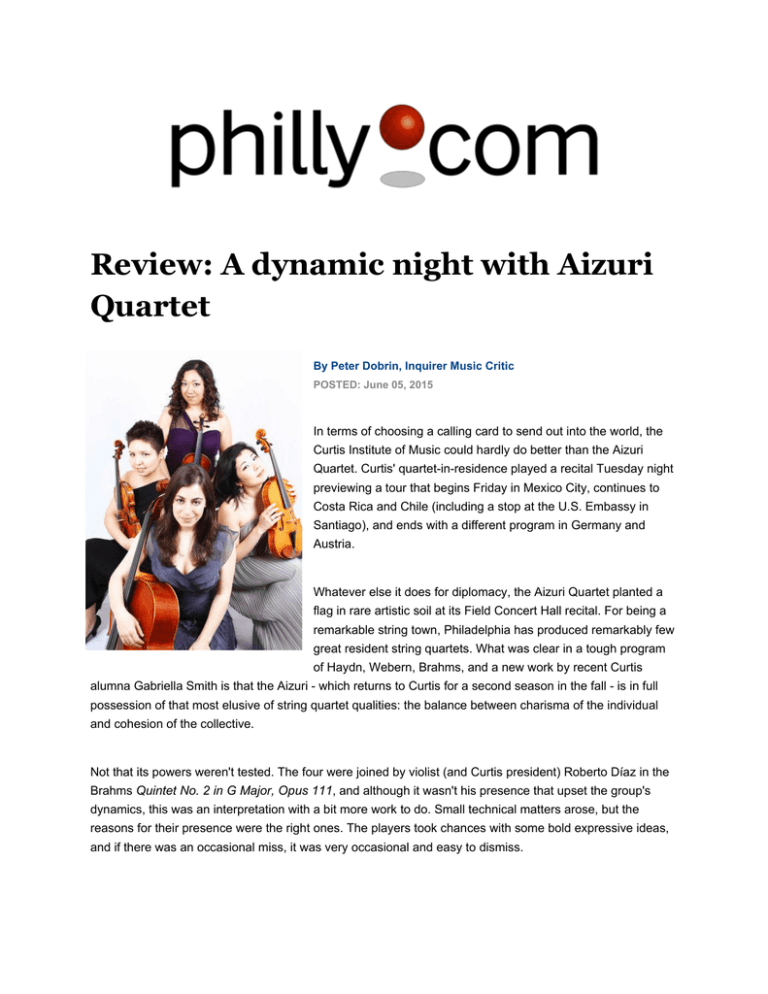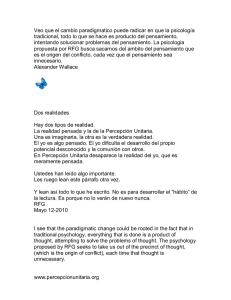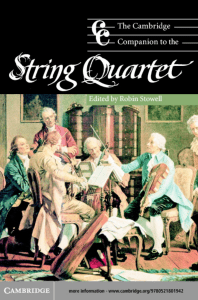Review: A dynamic night with Aizuri Quartet
Anuncio

Review: A dynamic night with Aizuri Quartet By Peter Dobrin, Inquirer Music Critic POSTED: June 05, 2015 In terms of choosing a calling card to send out into the world, the Curtis Institute of Music could hardly do better than the Aizuri Quartet. Curtis' quartet­in­residence played a recital Tuesday night previewing a tour that begins Friday in Mexico City, continues to Costa Rica and Chile (including a stop at the U.S. Embassy in Santiago), and ends with a different program in Germany and Austria. Whatever else it does for diplomacy, the Aizuri Quartet planted a flag in rare artistic soil at its Field Concert Hall recital. For being a remarkable string town, Philadelphia has produced remarkably few great resident string quartets. What was clear in a tough program of Haydn, Webern, Brahms, and a new work by recent Curtis alumna Gabriella Smith is that the Aizuri ­ which returns to Curtis for a second season in the fall ­ is in full possession of that most elusive of string quartet qualities: the balance between charisma of the individual and cohesion of the collective. Not that its powers weren't tested. The four were joined by violist (and Curtis president) Roberto Díaz in the Brahms Quintet No. 2 in G Major, Opus 111 , and although it wasn't his presence that upset the group's dynamics, this was an interpretation with a bit more work to do. Small technical matters arose, but the reasons for their presence were the right ones. The players took chances with some bold expressive ideas, and if there was an occasional miss, it was very occasional and easy to dismiss. The bigger ideas took shape all night in moments like this: an absolutely seamless back­and­forth dialogue between violinists Miho Saegusa and Zoë Martin­Doike in Haydn's String Quartet in B Minor, Hob. III:37; a beautifully liquid sound character in Webern's Langsamer Satz ; solo moments in the Brahms from violist Ayane Kozasa that were smooth as glass while still projecting; the gorgeously shaped and placed pizzicato notes of cellist Karen Ouzounian, also in the Brahms. Smith's new piece dazzled. Carrot Revolution was commissioned by Curtis and the Barnes Foundation, inspired somewhat by works at that museum. Generally high­voltage and wildly imaginative, the work nearly reinvents the sound of a string quartet ­ from percussion group to string ensemble and back again. Each successive section reestablished a new texture or a more complex repeated rhythmic scheme until a stretch where the music drooped ­ literally, the pitch slid down ­ and the energy relaxed. It's hard to think of another composer who has so radically changed the sound vocabulary of the string quartet while still making it seem absolutely idiomatic; this revolution is percussive, chantlike, feathery ­ even puckish. Until now, it had never occurred to me that a violin could hiccup, much less that I might be pleased to hear it. For English translation, see next review COMENTARIO DE LA SEMANA La explosiva fuerza del Aizuri Quartet El concierto del Aizuri Quartet en el CA660 de Corpartes podría calificarse como una de las grandes sorpresas de la oferta musical del presente año. A este juvenil conjunto, conformado por cuatro destacadas ex alumnas del prestigioso Curtis Institute de Filadelfia, le tocó presentarse en la misma semana que sus colegas del aclamado Cuarteto Leipzig. Esta coincidencia puede haber llevado a muchos a hacer una comparación ‘a priori’, sopesando experiencia (y renombre) versus juventud, un repertorio convencional versus un programa que supo equilibrar tradición con la vivencia de la música como un arte vivo, que tiene vigencia y actualidad. Y este último factor fue parte importante de la receta que convirtió a esta presentación en una cumbre de la temporada. El Cuarteto No.31 de Joseph Haydn fue la carta de presentación del conjunto integrado por Miho Saegusa (violín), Zoë Martin­Doike (violín), Ayane Kozasa (viola) y Karen Ouzounian (cello). Los talentos individuales de cada músico fueron apreciables en su aunado trabajo, que nos brindó un Haydn bien esculpido y abundante en riquezas sonoras. Garbo, expresión, cada matiz, cada impresión de matices mostraba a un grupo cuyo enfoque se sentía maduro. Y del padre del cuarteto de cuerdas, saltamos directo al presente, ya que le siguió “Carrot Revolution”, una obra comisionada por el Aizuri a Gabriella Smith , compositora estadounidense de tan solo 24 años, pero que demuestra un dominio total de su oficio. En su lenguaje confluyen la influencia del minimalismo con el uso de técnicas extendidas y texturas aleatorias, y en este sincretismo proteico Smith conforma un arco sonoro en cuyo transitar encontramos fuerza interpretativa, virtuosismo, actitud lúdica, o sea saca a relucir todo el potencial de las cuatro músicos. Cerrando la primera parte, un nombre esencial de la música del último siglo, de quien este año se cumplen siete décadas de su muerte. De Anton Webern el Aizuri interpretó su temprano fragmento para cuarteto marcado simplemente como “Langsamer Satz” (Movimiento lento). Esa anhelante melancolía tan propia del romanticismo tardío traslució de manera efectiva en las manos de estas damas, recordándonos de paso que es música que está ya a un paso del mundo expresionista. Y expresiva fue la versión, muy en sintonía con esa obra maestra de similar lenguaje que es “Noche Trasnfigurada” de Schoenberg. Hasta acá ya no había dudas de que se estaba ante una velada irrepetible e inolvidable. Para la segunda parte se sumó Roberto Díaz , violista reconocido mundialmente, actual presidente del Curtis Institute, y de quien podemos decir con orgullo que es chileno. El contundente Quinteto No.2 Op.111 de Johannes Brahms fue la obra escogida para esta colaboración donde la fuerza explosiva del Aizuri se reforzó con el magnífico sonido de Díaz. La obra se fue desenvolviendo brillantemente revelando hasta sus más íntimos recovecos, recordándonos de paso que el lenguaje brahmsiano no solo miraba hacia atrás de su tiempo, sino también hacia adelante, como muy bien expuso Schoenberg en su ensayo “Brahms, el progresista”. Y este Aizuri Quartet es un grupo que también sabe mirar hacia atrás y hacia adelante. Y lo hace de acuerdo a altos estándares artísticos, por lo que fuimos afortunados de poder apreciarlo en estas tierras. Álvaro Gallegos M. 18/06/2015 COMMENT OF THE WEEK The explosive power of the Aizuri Quartet The concert of the Aizuri Quartet in CA660 at Corpartes could be called one of the great surprises of musical presentations this year. This youthful group, made up of four outstanding former students of the prestigious Curtis Institute in Philadelphia, found themselves performing during the same week as their colleagues of the acclaimed Leipzig Quartet. This coincidence could have led many to make an a priori comparison, weighing experience (and renown) against youth, and a conventional repertoire against a program that could balance tradition with the experience of music as a living art, which is still relevant and contemporary. Indeed this last factor was an important part of the recipe that made this presentation a high point of the season. Joseph Haydn’s “Quartet No.31” was the calling card of the group, which is comprised of Miho Saegusa (violin), Zoë Martin­Doike (violin), Ayane Kozasa (viola) and Karen Ouzounian (cello). The individual talents of each musician could be appreciated in their ensemble work, which offered us a well­sculpted Haydn, overflowing with a wealth of sonority. Gracefulness, expression, and refinement­­each impression of nuances displayed a group whose focus felt mature. From the father of the string quartet, we leaped directly to the present, since what followed was “Carrot Revolution,” a work that Aizuri commissioned from Gabriella Smith, an American composer only 24 years old, who nevertheless shows complete mastery of her trade. In her musical language, the influence of minimalism flows together with the use of extended techniques and aleatory textures. In this protean syncretism Smith shapes a sonic arc in the crossing of which we find interpretative power, virtuosity, playfulness­­ that is, she highlights the full potential of the four musicians. The first part of the program closed with a name essential to the music of the last century, marked this year by the seventh decade since his death. Aizuri interpreted the early fragment for quartet by Anton Webern listed simply as “Langsamer Satz” (Slow Movement). This yearning melancholy, so characteristic of late Romanticism, shone through effectively in the hands of these women, reminding us in passing that this music is just a step away from the world of expressionism. Their rendering was expressive and very much akin to that masterpiece in similar language, Schoenberg’s “Transfigured Night.” By now it was quite clear that we were part of a unique and unforgettable evening. Joining in the second part was Roberto Díaz, the world renowned violinist, who is president of the Curtis Institute, and of whom we may proudly say is Chilean. Johannes Brahms’ overwhelming Quintet No. 2 Op.111 was the work chosen for this collaboration, where the explosive power of the Aizuri quartet was strengthened with the magnificent sound of Díaz. The work unfolded brilliantly, revealing even its most intimate recesses, reminding us in passing that the Brahmsian language looked not only back from his own time, but also forward, as Schoenberg said very well in his essay “Brahms, the progressive.” Indeed, the Aizuri Quartet is a group that is capable of looking back and forward, and it does so with the highest artistic standards. Thus, we were fortunate to be able to appreciate it on our soil. Álvaro Gallegos M. June18, 2015 IN: REVIEWS MARCH 15, 2015 Aizuri Brings Vigor and Depth by LEON GOLUB On a bleak afternoon, the Quartet in Residence at the Curtis Institute of Music, uplifted us with Haydn, Janáček and Schubert at Calderwood Hall as a feature of Curtis on Tour. Where some foursomes strive for perfect unity of voice, the Aizuri Quartet’s four individuals found each other through the music, bringing new life to well-known pieces. One of a set of twelve commissioned by Joseph Tost, former principal second violinist in Haydn’s Esterháza orchestra, Haydn’s String Quartet in B-flat Major, Hob. III:67, Op. 63, No. 3 shows the master fully in command of his art. The performance showed the Aizuri fully in command of Haydn’s restrained wit and humor, and completely aware of his importance for the future of the quartet form. Throughout, the quartet controlled the ebb and flow of the dynamics masterfully, with clear cadences and perfect tempi. The first movement vivace assai was exactly that: the “galloping” theme introduced by Karen Ouzounian’s cello was alert, vivacious but not rushed, down to earth and without pretense. The lovely adagio was elegant, with a good balance between forward movement and restraint. The menuetto, played a bit ländler-like, had Miho Saegusa’s violin take on the tone of a country fiddler, Ouzounian’s cello introducing a lively bounce. The Finale, fully taking into account the con spirito marking, was impelled by the cello, the violins dancing, and Ayane Kozasa’s viola tempering it and trying to mediate. Janáček wrote his String Quartet No. 1 during a burst of creativity in 1923, finishing it in only two weeks. Subtitled “Kreutzer Sonata” after the Tolstoy story and with references to the Beethoven Kreutzer Sonata, the piece reveals much about Janáček’s anguish over being trapped in an unhappy marriage and passionately in love with a married woman 38 years his junior. It is perhaps the apex of his chamber output—a bold and original composition eschewing traditional forms and tonalities. As though deeply conversant with Tolstoy’s story, the quartet played the short but intense work with a clear awareness of the terror of uncontrollable passions. The opening adagio was tense and violent, Zoë Martin-Doike tearing phrases from the violin, arguing with Kozasa’s viola. A swift mood change brought obsession and nervousness from the cello, all fading away ambiguously. The second movement began as a slow dance passed from viola to second violin to first, with danger and horror overlaid by sul ponticello agitation, deep mournful moans in the cello, obsessive mania in repeated short nervous phrases from violin and viola, ending in disintegration. The third movement began with a yearning, reflective mood, interrupted by buzzing sul ponticello demons that took over the space. The atmosphere grew increasingly haunted and grotesque, engulfing even the capacity for reflectiveness. The final movement then presented us with the calm of devastation. We live in the desert of our own destructiveness. The movement grew into a cacophony of unbearable ferocity followed by incurable sadness. It is hard to believe that Schubert’s magnificent Quintet in C Major, D. 956, remained unpublished and unheard until more than two decades after the composer’s death. Written in the 18 months between Beethoven’s death and Schubert’s own, it is one of the great Romantic chamber works and a key element of Schubert’s legacy. It comes as close as anything to depicting what the philosopher Jean-Luc Marion calls the “saturated phenomenon,” unknowable in its quality, overwhelming and blinding our intuition. Peter Wiley of the Curtis Institute and famously from the Guarneri Quartet, joined the Aizuri as second cello, and the quintet built the performance around a pivotal moment near the end of the second movement adagio, an epiphany that gives meaning to the entire structure. The long first movement, played to perfection, was an exploration of the grandeur and solitude of human fate, a grappling with mortality, at times finding melodious beauty, at other times crushed by despair. At the end, we were left with a noble resolve in the face of tragedy. But then we had the miracle of the adagio in the guise of a vigil, outside of time, driven by an inner pleading from the first violin. The steady forward motion lifted us to a landscape of light and beauty. At the very moment when this unfamiliar space was recognized as home, we were plunged into a violent anguish of almost unbearable and convulsive power. The five players stayed with the anguish, not rushing through it, and gave full weight to the repeated silences that bring it to a close. In these silences an epiphany occurred, the pivotal moment of the entire quintet, leading to a return of the opening of the adagio, but imbued with gratitude, trust, hope and above all, celestial peace. The scherzo conveyed firm but rapturous joy, a liberation, the expansiveness arising from a rigorous encounter with a higher truth. This was confirmed by the Trio section in which, thanks to the quintet’s beautiful phrasing, anguish was replaced by a capacity to will the inevitable. The allegretto finale, with fear gone and despair dissolved, rose to a higher state of generativity—loving life in the face of death. We were invited to view, from a remove, the wisdom of peasant dances that celebrate life, seasons, communal tasks and inter-generation transmission. Saegusa’s violin briefly paid homage to Vivaldi, to the beauty of nature and the rhythms of the biosphere. A brief homage to Haydn emerged in a distinctly Viennese gracefulness. Moments of regret mingled with the joy of the here and now, even as time rushed to its end, a current of the unstoppable.




